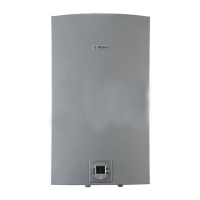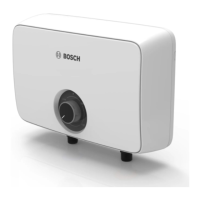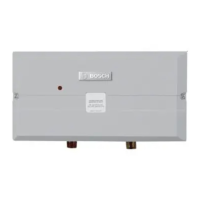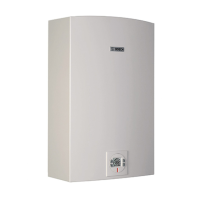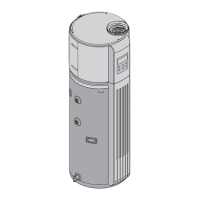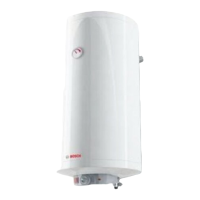Installation instructions
29
C 950/C 1050 (Pro TL 175 C/199 C) – 6 720 805 440 (2019/10)
External condensate drain installation
If an external condensate drain (installer supplied) must be
installed (chapter 4.3.2), the following is recommended:
• 1. Install condensate drain on a horizontal section of the
exhaust pipe as close to the heater as possible.
• 2. The condensate must be disposed of according to local
codes.
• 3. To install condensate drain in vent system, use PVC 3" X
3" X 1.5" tee (part# 196278) and reduce for drain
connection
Fig. 21 External condensate drain installation
[1] Condensate drain
[2] Dispose of condensate in accordance with local codes
[LA] Minimum 4"
4.3.6 Freeze prevention for PVC, CPVC, and ABS systems
In cold climates, components of a tankless water heater can
freeze and burst from negative draft. A leading cause of
negative draft is combustion appliances in the building not
being supplied with sufficient combustion air. A wood stove or
furnace can pull its combustion air from the water heater‘s vent
pipe, allowing the cold incoming air to freeze the cold water in
the heat exchanger. The best prevention for this risk is two pipe
venting which draws the appliance combustion air from
outside.
Listed below is an additional measure designed to further limit
backdraft in conditions where there is a high risk of freeze
damage.
Backdraft reducer
The Heat Fab backdraft reducer (9301BFP) is the preferred
option for limiting backdraft (see fig. 22).
Note: The following solution is available only for 3"
diameter venting.
Fig. 22 Part # 9301BFP
Installation
For this solution to be effective, the internal flapper must be
100% closed when the water heater is not running. Refer to
Figures 24 and 25 for preferred installation positions in the
vent system.
Installation considerations:
• Install damper per the supplied manufacturer‘s
instructions.
• The damper is only to be used in the exhaust vent piping.
• Ensure directional arrow on damper label faces in the same
direction as exhaust flow.
• If installed horizontally, the axis must be horizontal or
slightly pitched up towards termination to ensure damper
closes 100% when heater is not running.
• To allow accessibility, damper must not be installed in an
enclosed section of vent pipe.
• Do not install damper in unconditioned spaces (e.g. attics)
Condensation can build up while the heater is running
which can later freeze and potentially block the flapper.
Fig. 23 Blackflow reducer (9301BFP) installed

